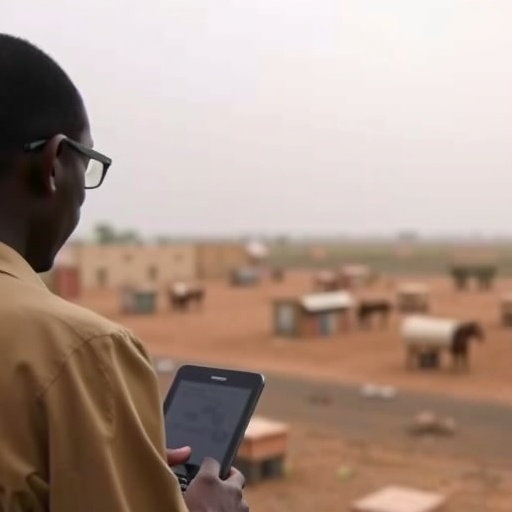In times of crisis, particularly during conflicts, healthcare services can become severely disrupted, leaving vulnerable populations without essential medical support. In the context of wartime Sudan, where millions have been displaced due to ongoing violence and instability, the dynamics of healthcare delivery have shifted significantly. Recent research has unearthed critical insights into how teleconsultation is being utilized among internally displaced persons (IDPs) in this war-torn region. The study illuminates the vital role that technology plays in bridging the gap between healthcare providers and IDPs while identifying the key determinants influencing this shift toward telehealth services.
For many, the concept of teleconsultation may seem like a modern convenience reserved for stable environments. However, in regions such as Sudan, it is emerging as a lifeline for those whose access to traditional healthcare services is limited or nonexistent due to the ongoing conflict. The ability to consult with healthcare professionals remotely not only enhances access but also fosters continuity of care amidst a backdrop of chaos and uncertainty. The implications of this research extend far beyond the borders of Sudan, questioning how telehealth can be effectively implemented in similar crisis situations worldwide.
One of the most striking findings of the study is the strong correlation between access to technology and the utilization of teleconsultation services among IDPs. Those with smartphones or internet access were significantly more likely to engage with telehealth platforms. These individuals often possess pre-existing knowledge about digital tools, enhancing their ability to navigate complex healthcare systems during emergencies. Conversely, those lacking technological access often find themselves falling further behind, underscoring a growing digital divide that can exacerbate health disparities in vulnerable populations.
The research also delves into the myriad factors that influence the choice to engage with teleconsultation services. It reveals that health literacy plays a pivotal role in determining whether an individual feels empowered to seek help through digital means. IDPs with higher levels of health literacy are more likely to understand the importance of telehealth and its functionalities, enabling them to utilize these services effectively. Conversely, a lack of understanding can perpetuate feelings of helplessness and disengagement from essential healthcare resources.
Another significant determinant highlighted by the research pertains to the socio-cultural context that shapes how communities perceive and utilize telehealth services. In many cultures, traditional face-to-face consultations are the norm, and the shift to a digital modality can encounter resistance. This resistance may stem from a mistrust of technology or unfamiliarity with its applications in healthcare. Therefore, fostering an environment that encourages digital engagement through education and reassurance can be instrumental in enhancing telehealth adoption among IDPs.
The mental health implications of accessing teleconsultation services are profound and cannot be overlooked. The study reveals that many IDPs face stress, anxiety, and depression due to their circumstances, and the ability to consult with a healthcare professional remotely can provide not just medical assistance but also psychological support. Telehealth opens new avenues for mental health interventions, allowing individuals to seek help without the stigma associated with in-person visits.
Notably, the researchers also emphasize the importance of training healthcare providers in telehealth practices. It is not enough to merely provide teleconsultation platforms; healthcare workers must be equipped with the necessary skills to deliver effective care remotely. The study advocates for targeted training programs that can enhance the capabilities of providers to engage effectively with IDPs, ensuring that the quality of care remains consistent regardless of the modality.
While the research presents a cautiously optimistic view of teleconsultation’s potential in crisis scenarios, it also identifies substantial challenges that remain. Connectivity issues, particularly in rural and conflict-affected areas, can hinder the effectiveness of telehealth solutions. Many IDPs may struggle with poor internet access, limiting their ability to engage with healthcare providers. Addressing these infrastructural gaps will be essential in harnessing the full potential of teleconsultation in such environments.
In tandem, the study highlights the need for policymakers to prioritize telehealth initiatives amid the ongoing humanitarian crisis. Resources must be allocated to developing reliable telehealth infrastructure and training programs that can facilitate teleconsultation adoption. By creating an enabling environment that supports both healthcare providers and patients, governments and organizations can ensure that telehealth becomes an integral component of healthcare delivery in crisis settings, fulfilling the needs of the most vulnerable populations.
Furthermore, the insights derived from this research can inform future studies and interventions aimed at understanding how telehealth can be effectively utilized in other conflict zones. The unique challenges faced by IDPs in Sudan can provide valuable lessons for other regions grappling with similar circumstances. This research underscores the need for ongoing collaboration between healthcare providers, technology companies, and humanitarian organizations to better serve the needs of IDPs, ultimately working towards more resilient healthcare systems.
As digital tools continue to evolve, the importance of integrating these technologies into healthcare delivery, even in the most challenging environments, cannot be overstated. The findings of this research not only illuminate the current state of teleconsultation among IDPs in wartime Sudan but also pave the way for future innovations that can address healthcare delivery where it is needed most. As conflicts rage and displacement continues, the role of telehealth in shaping equitable healthcare access may prove crucial in fostering recovery and resilience among affected populations.
In conclusion, the study serves as a clarion call to prioritize telehealth solutions for internally displaced persons, particularly in crisis contexts. The intersection of technology, healthcare, and humanitarian response illustrates the complexities of providing care in conflict-ridden regions. By leveraging teleconsultation, stakeholders can enhance healthcare access, improve health outcomes, and address the pressing needs of individuals enduring the hardships of displacement.
The transformational potential of telehealth is evident, but it requires concerted efforts from all sectors to ensure that these solutions are effectively implemented and adapted to the unique challenges posed by crises like those in Sudan. As we look to the future, fostering an environment of innovation and collaboration will be critical in navigating the complexities of healthcare in global crises.
Subject of Research: Teleconsultation and its use among internally displaced persons in wartime Sudan.
Article Title: Navigating crisis: teleconsultation use and its determinants among internally displaced persons in wartime Sudan.
Article References:
Mahgoub, E.A.A., Nouri, M. Navigating crisis: teleconsultation use and its determinants among internally displaced persons in wartime Sudan.
BMC Health Serv Res 25, 1334 (2025). https://doi.org/10.1186/s12913-025-13430-0
Image Credits: AI Generated
DOI:
Keywords: Teleconsultation, internally displaced persons, healthcare delivery, wartime Sudan, health disparities, technology access, health literacy, mental health support, training healthcare providers.
Tags: continuity of care in conflictdigital health in emergencieshealthcare access for displaced personsimplications of telehealth researchinternally displaced persons telehealthremote healthcare solutionsSudan healthcare challengestechnology in crisis healthcareteleconsultation in wartimetelehealth implementation in crisestelehealth in conflict zoneswar and healthcare delivery





